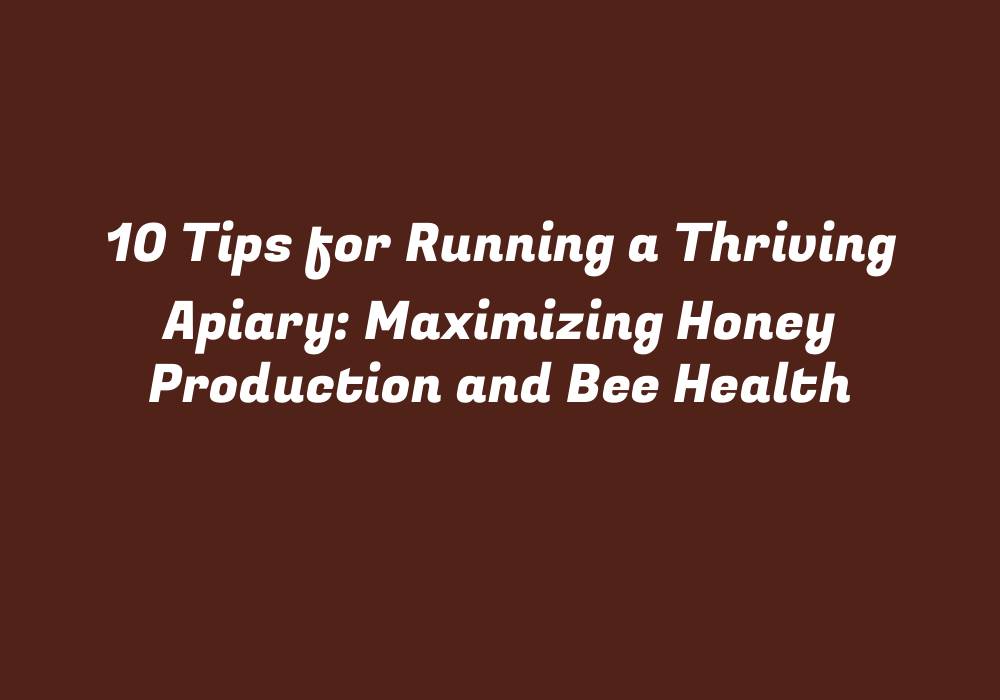10 Tips for Running a Thriving Apiary: Maximizing Honey Production and Bee Health
Introduction
Bees play a significant role in the ecosystem as they are responsible for pollinating plants, leading to fruit production. However, their importance has extended to humans’ lives with honey being an essential product of beekeeping. An apiary refers to a bee farm where beekeepers manage and maintain hives for various purposes. This article focuses on ten tips that can help you run a thriving apiary, maximize honey production, and improve the overall health of your bees.
1. Choose Suitable Apiary Location
The first step in starting an apiary is choosing the right location. Consider factors like climate, terrain, vegetation, and proximity to other potential beekeepers. Look for a spot that is sheltered from strong winds but receives enough sunlight for adequate nectar production. Also, ensure there is ample space for bees to gather pollen and nectar from flowers nearby.
2. Maintain Hive Health
A thriving apiary requires healthy hives that are free from pests and diseases. Regularly inspect hives, monitor bee activity, and keep the interior clean to prevent the spread of diseases like American foulbrood or European foulbrood. Also, maintain proper ventilation, control moisture levels, and replace old combs when necessary to ensure a healthy environment for your bees.
3. Feed Your Bees Properly
Proper nutrition is essential for maintaining healthy bee colonies. Make sure you provide them with enough food sources by managing hives near flowering plants that produce ample nectar and pollen. You may also consider supplementary feeding during periods of dearth, like winter or when there is a scarcity of floral resources. Provide honey-alternatives such as sugar syrup or bee candy to ensure the bees have enough energy for foraging.
4. Manage Bee Population Wisely
Monitoring the population growth and health of your colonies will help in maintaining optimal conditions within the hives. Add new queens when needed, remove unproductive colonies, and control swarming behavior by providing adequate space for bees to grow within the hive. Also, pay attention to the ratio between drones, workers, and queen bees to ensure a balanced population that works effectively in pollination and honey production.
5. Manage Pests and Predators
Protect your apiary from pests like wax moths and predators like bears or raccoons by implementing preventive measures. Keep the apiary area clean, secure beehives with mesh wire, use pheromone traps to catch pests, and monitor for any signs of infestation. Additionally, educate yourself on local wildlife and potential threats in your area to better understand the necessary precautions you need to take.
6. Manage Hive Expansion and Splitting
As your apiary expands, it’s important to manage hive growth effectively. When a colony grows too large, consider splitting into multiple colonies or transferring some bees to new hives to prevent overcrowding and maintain healthy conditions for the bees. This also helps in increasing honey production by providing more resources for each colony.
7. Monitor Honey Production
Regularly monitor your apiary’s honey production levels, including the amount of honey stored and nectar flow rates. By doing so, you can identify trends that may affect your bees’ productivity and make appropriate adjustments to enhance their output. Also, keep a record of floral resources nearby and adapt hive management practices based on the availability of these resources.
8. Maintain Hive Biodiversity
Promoting biodiversity in your apiary can lead to better bee health and increased honey production. Plant a variety of flowering plants that bloom at different times throughout the year, providing diverse nectar sources for your bees during all seasons. By doing so, you will create a more resilient ecosystem where bees have access to ample pollen and nectar sources.
9. Embrace Sustainable Practices
Implementing sustainable practices in your apiary can significantly improve honey production and bee health while protecting the environment. Use organic or natural methods for pest control, avoid the use of chemicals within the hives, and minimize environmental impact by reducing energy consumption in honey extraction processes.
10. Network with Other Beekeepers
Lastly, fostering connections and learning from other beekeepers can help you grow as an apiarist and improve your apiary’s overall management and performance. Participate in local beekeeping associations or clubs, attend workshops, and seek advice from experienced beekeepers to expand your knowledge and make better decisions for your apiary.
Conclusion
Running a thriving apiary not only requires careful planning but also dedication and continuous learning to ensure the well-being of honeybees and maximum honey production. By following these tips, you can successfully establish an apiary that benefits both the bees and their surrounding environment. Remember to continuously monitor and adapt your management practices based on your apiary’s unique circumstances for a sustainable and productive beekeeping venture.
